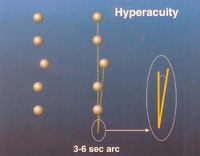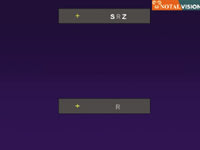PHP May Serve as an Early Detector of Recent-Onset CNV
A 10-month clinical trial showed high sensitivity
and specificity. How will it be used?
BY KEITH CROES
A new test instrument from Carl Zeiss Meditec, the PreView PHP, is designed to detect the conversion from the intermediate "dry" stage of age-related macular degeneration (AMD) to recent-onset choroidal neovascularization (CNV) before irreversible damage has occurred and before the patient is symptomatic.
Proponents of this new technology say it eliminates the shortcomings of the traditional but unsophisticated Amsler grid test, and that the PHP's capabilities will enable clinicians to intervene earlier with appropriate treatment.
In a study reported at the 2004 annual meeting of the American Academy of Ophthalmology (AAO), the device demonstrated greater than 80% sensitivity and specificity in patients with CNV and intermediate AMD. These numbers are consistent with the expectations of Yair Alster, MD, who developed the instrument.
"Early detection is the single most important factor in final visual outcome," says Dr. Alster.
The device, a preferential hyperacuity perimeter (hence PHP), may have useful applications in both the retinal specialty and the general ophthalmology practice, according to retinal physicians familiar with the system. While the PreView PHP may have the potential to dramatically improve the correctness of referral to retinal specialists, its inventor also sees a place for the instrument in the specialist's office, as a tool for measuring macular function outside the fovea and determining the effect of treatments on the entire macula.
In this article, several experts comment on the potential applications of the PreView PHP.
RANGE OF APPLICATIONS COULD BE BROAD
"The greatest application in primary eye care may be in the diagnosis of wet AMD," says Jeffrey Heier, MD, who practices in a 20-physician multispecialty group in Boston, one of the study centers for the instrument. "If a patient you've never seen before comes in with mild metamorphopsia and mild changes in Amsler grid testing, the PHP may aid in earlier diagnosis."
According to Michael Ip, MD, associate professor of ophthalmology at the University of Wisconsin's Fundus Photograph Reading Center, PHP may also be helpful to the general ophthalmologist in situations where access to fluorescein angiography (FA) is limited. The information provided by PHP may also contribute to more appropriate referrals, he adds. "In a general ophthalmology practice that sees a lot of patients with retinal disease, the PHP might prove very useful," he says.
As with the development of optical coherence tomography (OCT), the applications of PHP likely will grow over time as ophthalmologists gain experience with the test. Baseline and serial PHP testing may have increasing influence over treatment decisions and conceivably reduce the need for FA or repeat FA.
A CONFIRMATORY TEST
Currently, though, PHP is primarily confirmatory: "PHP is not diagnostic by itself," says Dr. Ip. "Its most important application is distinguishing intermediate AMD from early-onset CNV, which a clinical exam does not always do with high specificity and sensitivity. This is becoming an issue because data indicate that detection of early, smaller CNV lesions leads to better visual outcomes."
Dr. Heier agrees that the retinal specialist shouldn't rely solely on PHP, and notes that he isn't routinely using PHP in his practice. When patients are referred for exudative AMD, "we may get an FA," he says, "and we may also do a baseline PHP to compare to future changes." His practice is studying how PHP may augment OCT in following patients who have received photodynamic therapy or other retinal treatment. "We may find it very useful for quantifying more subtle treatment effects," he says.
Although he also participated in studies of PHP, like Dr. Heier, Dr. Ip isn't routinely using PHP. The reimbursement issues have yet to be worked out, he notes, and PHP isn't indispensable. (Carl Zeiss Meditec is currently working with CMS to determine how reimbursement for testing with the PreView PHP instrument might be structured.)
"I can make most diagnostic distinctions based on clinical examination," he says, "and use the gold standard, FA, if I think it's necessary. Although I think PHP would be a nice adjunct in the retinal practice, I don't see it ever replacing FA and clinical exam."
Neither has it been established how often PHP testing should be performed. "We don't have data to support PHP as a monitoring device," Dr. Heier notes. "It picks up abnormalities. There are no clearcut guidelines yet on how often it should be used. If I have a patient with advanced or exudative AMD in the fellow eye, I'll do a baseline PHP in that patient. But I probably wouldn't obtain another PHP unless the patient had some degree of symptoms, or unless there were some questions -- something suspicious but not quite enough to prompt me to order a fluorescein. If the PHP test was unchanged from baseline in that case, that patient might be saved from getting a fluorescein."
Although the recommended frequency of PHP testing hasn't been established, Dr. Ip suggests that relatively frequent testing -- every few months or so -- might be useful in a general ophthalmology practice.
Whether PHP testing reveals a high probability of intermediate or exudative AMD, the results shouldn't be considered definitive, Dr. Ip notes. "I would caution anyone using PHP not to take the results as some kind of gold standard; it's an adjunct to clinical assessment or evaluation. If it confirms your suspicion, then proceed appropriately. If you suspect that a patient might have exudative changes despite PHP results that suggest that the patient has intermediate AMD, you need to proceed with FA and treat as if the patient might have exudative disease."
|
|
|
|
The ability of the eye to detect misalignments is in the magnitude of 36 seconds of arc -- a "talent" 10 times more sensitive than standard visual acuity. This ability is largely unaffected by
contrast sensitivity, age, or media opacities. |
|
HOW THE TECHNOLOGY WORKS
The PreView PHP quantifies distortion in the central visual field by exploiting the hyperacuity phenomenon: the ability to detect the misalignment of an object's location relative to other objects in space.
The test stimuli are collinear sets of points (dots) that include one or more dots positioned at different locations relative to the basic collinear pattern. Different magnitudes of artificial distortions in the test stimuli compete with the patient's actual pathological distortions caused by AMD. The patient's attention will be drawn to the greater of the two stimuli; that is, the artificial distortion in the dot deviation signal or the patient's own pathological distortion. This phenomenon is known as "preferential looking."
The test, which takes approximately 5 minutes per eye, is easily administered by a technician or clinic staff member. The patient first looks at a computer screen, blank except for a fixation dot in the center. A single straight line, consisting of a series of closely spaced dots with one dot out of alignment, is flashed somewhere on the screen for 160 milliseconds. The human visual system is known to be very good at detecting misalignment, a talent referred to as "hyperacuity." In fact, this ability is 10 times more sensitive than standard visual acuity.
RESULTS OUTPUT
When taking the test, the patient indicates on a touch-sensitive screen the point that represents the location of the most prominent distortion. The instrument records whether the patient noticed either the artificial or pathological distortion, both distortions, or that the patient didn't notice either distortion. A new dot then appears on the screen where the patient touched with the stylus. The new dot then moves across the screen toward the fixation dot in the center, drawing the patient's attention. When the dots merge, another line is flashed at a different location on the screen, and the process repeats.
By varying the magnitude of the artificial distortions and identifying areas where the patient marked the pathological distortions, the system quantifies the relative size and extent of the visual field defect.
Between 68 and 102 test signals are displayed for
160 ms, covering the central 14º of the macular visual field. Five hundred retinal data points are tested 35 times each. A 0.75º spatial resolution enables the detection of lesions as small as 450 microns.
The system analyzes results automatically utilizing an algorithm that compares responses with a normative database of 500 intermediate AMD and CNV patients. A map of visual field defects is generated together with confidence and reliability parameters. The confidence level indicates the likelihood that the test results are consistent with CNV or with intermediate AMD.
The system supports office networking and remote printing through the Windows XP operating system. Extensive data management and backup features are included. A removable 128-MB flash memory contributes to media storage and convenient transfer of patient records.
|
|
|
|
Because the PHP flashes 1 line at a time, there's no lateral inhibition of perception, and the "crowding" phenomenon associated with the Amsler grid is eliminated. Thus, the patient can detect distortions more
accurately. |
|
TEST ACCURACY
In case studies reported by the manufacturer, FA of both juxtafoveal CNV and extrafoveal CNV corresponded to visual field defects seen in PHP test results. Comparison to the normative database confirmed a high confidence that the PHP results were consistent with CNV, with a concomitant low incidence of false-negative and false-positive errors.
Similarly, in a patient with numerous large drusen consistent with intermediate AMD, as seen by red-free photography, PHP determined with a moderate level of confidence that the test results weren't consistent with CNV, supported by a low incidence of false-negative and false-positive errors.
In results reported at the 2004 AAO meeting, the instrument wasn't able to measure 12% of study patients, a finding that is being further reviewed. Investigators concluded, however, that 8 of 10 patients who develop CNV can be detected earlier with PHP than without the use of the new test.
As the study of PHP in the clinical setting continues, the test ultimately may prove to be beneficial as a self-administered home test. "If PHP proves to be advantageous, maybe it can be adapted to an affordable home unit," Dr. Heier says. "I don't think it will be like an Amsler test, which many patients self-administer as often as several times a week. But almost everyone has a computer these days. Can PHP be adapted to a home computer so that patients can test themselves every few months?"
If further research continues to confirm the utility of the PreView PHP in revealing early CNV, and establishes a role for the instrument in monitoring disease and disease treatment, there are many retinal specialists who would be likely to welcome that development.
Keith Croes is president of Croes Communications, Inc., and a veteran medical editor, consultant and communicator.










